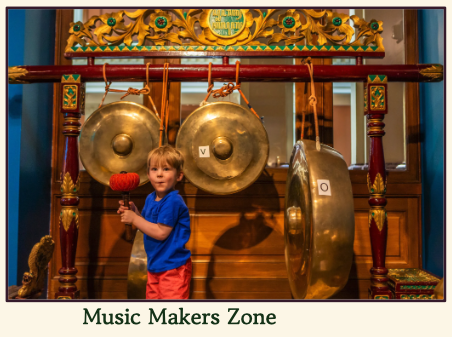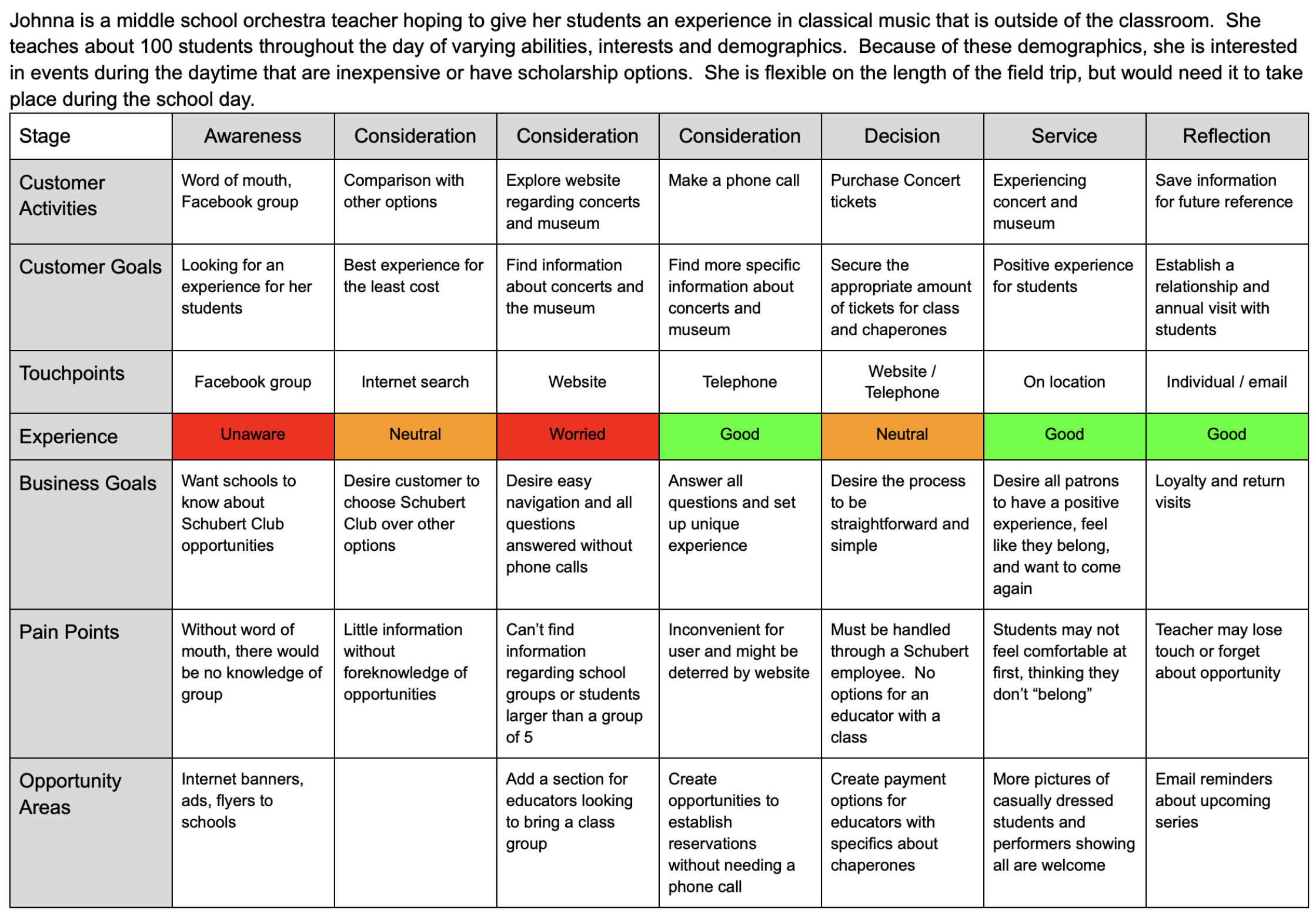The Schubert Club
“I can’t believe how much this place has to offer!”
Team - Matt Collins, Lauren Hoerr, Liz Chiles, Mamoun Alassouli
Role - Team Leader, Heuristic Analysis of website, User Journey Map, Prototyper.
Date - December, 2024
Methods - Usability Testing, Competitive Analysis, Heuristic Analysis, User Journey Map, Artifact Analysis, Annotated Wireframes, Prototyping, Findings and Recommendations Report
Tools - Google Suite, Figma, Figjam
Background
The Schubert Club, founded in 1882, is one of the oldest music organizations in the United States. Established by a group of visionary women dedicated to fostering the arts in the Midwest, the organization was named in honor of Franz Schubert, the renowned 19th-century Austrian composer celebrated for his exquisite melodies and pioneering contributions to chamber music.
Located on the second floor of the historic Landmark Center in St. Paul, Minnesota, the Schubert Club’s headquarters also house its fascinating Music Museum. Today, the organization continues to inspire a love for music through two primary endeavors: hosting world-class concert series and curating its rich and educational Music Museum, making it a cornerstone of cultural life in the region.
The Schubert Club’s in-house museum is a treasure trove of musical history and discovery, featuring three remarkable galleries that invite visitors to immerse themselves in the world of music.
The Music Makers Zone offers a rare, hands-on experience where every instrument is playable, inspiring creativity and a deep, personal connection to the art of sound.
The Piano Journey houses an extraordinary collection of keyboard instruments, tracing their evolution across cultures and centuries, offering insight into the innovation and artistry that shaped music as we know it today.
The Recital and Manuscript Collection provides an intimate glimpse into the minds of legendary composers, displaying original handwritten documents by Mozart, Grieg, Chopin, and others, allowing visitors to stand face-to-face with history.
Remarkably, this entire experience is offered free of charge, a reflection of the Schubert Club’s unwavering commitment to making the beauty and wonder of music accessible to all who walk through its doors.
The Schubert Club entrusted our team with addressing two key challenges aimed at attracting and retaining concert attendees and museum visitors. These concerns were consistently highlighted during our usability testing and reinforced through a comprehensive designer analysis of the website, underscoring their importance to both users and stakeholders alike.
Problem and Purpose
First, users expressed uncertainty about the process of acquiring tickets to concerts, which can create a barrier for potential attendees. To make their events more accessible and welcoming, especially to new audiences, the Schubert Club recognizes the need for a ticketing process that is clear, intuitive, and user-friendly. Ensuring simplicity and transparency in this process is a crucial step toward fostering inclusivity and encouraging broader participation in their events.
Second, the website lacks detailed and engaging information about what visitors can expect at the museum. This ambiguity leaves potential patrons unsure of whether the museum is designed for children, music enthusiasts, tourists, or a combination of these audiences. A more inviting and comprehensive presentation of the museum’s offerings is essential to clarify its appeal and ensure it resonates with the diverse groups it aims to attract.
Iteration and Evaluation
Usability Testing
Our team initiated the project by conducting usability testing with users possessing varying levels of familiarity with the Schubert Club. During this process, participants were tasked with completing a series of activities, such as purchasing tickets for a concert series and exploring the museum section of the website. The insights gathered were carefully analyzed and synthesized to identify patterns and overarching themes, highlighting the expectations users had and the gaps where those expectations were not being met. This approach provided a clear foundation for understanding user needs and prioritizing areas for improvement.
A heuristic analysis was conducted to identify specific usability issues on the Schubert Club’s website. This process provided valuable insights into the underlying problems and offered a clear framework for addressing the challenges the Schubert Club sought to resolve. By evaluating the website against established usability principles, we were able to pinpoint key areas for improvement and develop actionable solutions to enhance the user experience.
Heuristic Analysis
We conducted a competitive analysis to explore how other museums assist visitors in discovering and engaging with their offerings. This process yielded valuable insights into the strategies employed by world-renowned museums to attract visitors and foster long-term patron loyalty. By examining their approaches to showcasing exhibits, communicating value, and enhancing accessibility, we identified best practices and innovative ideas that could be adapted to elevate the Schubert Club’s visitor experience.
Competitive Analysis
A User Journey map was developed to personify the user experience and provide a holistic view of how individuals interact with the Schubert Club’s offerings. This process allowed us to identify key pain points and uncover areas of opportunity where enhancements could significantly improve the user experience. By mapping the journey, we gained a deeper understanding of user needs, emotions, and expectations, enabling us to propose targeted solutions that align with the Schubert Club’s goals.
User Journey Map
During the development of the prototype, wireframes were carefully annotated to highlight the key changes implemented to enhance the user experience. These annotations provided clear explanations of the adjustments made, emphasizing how each change addressed user pain points or improved functionality. This process not only ensured transparency in design decisions but also served as a guide for aligning the final product with the Schubert Club’s goals and user expectations.
Annotated Wireframes
Prototype
Finally, an interactive prototype was developed using Figma, offering a detailed visualization of the major enhancements made to the Schubert Club’s website. Accompanying the prototype is a video walkthrough that highlights key updates and solutions.
The video addresses improvements to the website’s landing page, enhanced visibility and branding for the music museum, and a streamlined ticketing process for concert series. These updates were designed to create a more user-friendly and engaging experience for visitors.
Additionally, a new feature was proposed and developed—a dedicated Educator’s section. This section was designed to assist teachers in planning meaningful musical experiences for their students, fostering interest and engagement with the Schubert Club among younger audiences. By building connections with educators and students, this initiative aims to inspire a new generation of music enthusiasts and cultivate long-term loyalty to the organization.
Given additional time on this project, I would focus on further enhancing the Music Museum’s presence, particularly for those who cannot physically visit the museum. There is immense potential to expand accessibility by developing a virtual, interactive experience that brings the museum’s offerings to a global audience.
Envisioning a VR experience, users could “walk” through the museum’s galleries from the comfort of their own homes, exploring exhibits and interacting with instruments in a fully immersive environment. Such an innovation would allow patrons to engage with The Music Makers Zone, The Piano Journey, and The Recital and Manuscript Collection in a way that feels tangible and personal, regardless of their location.
This virtual expansion would not only democratize access to the museum but also position the Schubert Club as a forward-thinking institution committed to sharing the beauty of music with a broader audience. It’s an opportunity to redefine how patrons connect with the museum and deepen their appreciation for its treasures.












